Wilting Plants Monitoring
A wilting plant is a sign of abnormal development. Often, wilting of plants occurs due to excessive nutrient supply or overwatering. Vegetation droops due to a lack of nutrients or moisture. Also, crop health disruption may result from weather extremities or because pathogens in plants cause wilting. Irrespective of the cause, it is important to identify the problem in time, and satellite imagery analytics help do it remotely.
What Is Most Likely To Cause Wilting In Plants?
Despite fading plants look the same, the exact cause in each case may be different, and every crop type has its wilting point – the critical amount of moisture not to droop. The common causes of wilting in plants are:
- heat or cold stress;
- damage due to hail or strong wind;
- excess or lack of soil moisture;
- poor soil aeration;
- osmotic stress due to soil salinity;
- pest infestations or suppression by weeds;
- pathogens attacks and plant diseases;
- root disturbance during irrigation;
- fertilizer burn or nutrient starvation.
Let’s consider the most probable causes in detail.
Plants Wilting From Heat And Cold
Farmers in drought-prone regions often witness plant wilting in summer when days are dry and hot. It happens due to fast evaporation and a lack of hydration. Often, faded foliage is simultaneously a sign of drought stress and a protective reaction: downward-looking leaves are less exposed to the sun. Besides, plants wilting in hot weather may occur due to drying winds even under sufficient soil moisture.
Early seeding implies a high risk of wilting of a plant caused by cold weather. During the late growing season in fall, there is a strong probability of crop damage by frost. Freezing temperatures block moisture and nutrient supply to plants because water crystallizes in their cells and soil. Typical vegetable plants wilting during frost (31-33°F/-0.5/+0.5°C) are cucumbers, peppers, tomatoes, aubergines, potatoes, peas, beans, corn, and others.
You can monitor crop health with satellite-based vegetation indices. Their efficiency depends on the phenological stage and varies during the season. However, regardless of what index you choose to use, any of them will signal trouble.
For example, barley was gradually growing until the average day temperature exceeded the tolerable limits, changing the vegetation state. The graph shows that the NDVI curve started to drop after November 19 due to drought stress in plants wilting in the field partially and then completely.

EOSDA Crop Monitoring
Offering high-resolution satellite images for fields analytics to monitor crops health remotely!
Plant Wilting After Watering Or Lack Of Moisture
Either poor or excessive water supply damages plants and may result in crop wilting. While waterlogging causes root rots, vegetation suffers from water stress under a lack of moisture. Among other symptoms, a water lack or overwatering can be visually diagnosed by plant leaves wilting. More conveniently, EOSDA Crop Monitoring has a number of features to assist in tracking vegetation health and water needs remotely:
- Vegetation indices tell the crop state, and their daily monitoring helps avoid irreparable plant stresses with symptoms of wilting by managing problems early.
- NDMI map shows canopy water content. When values drop, plants are wilting due to a lack of moisture. NDMI maps on EOSDA Crop Monitoring allow detecting a dehydration process in wilting plants even before the visual symptoms of chlorosis.
- Soil moisture data. EOSDA Crop Monitoring users can analyze soil moisture charts for two earth layers: the topsoil (surface) and the root zone. Amounts of soil moisture on each layer are important and the norms are specific for the crop type and the stage of growth. Regular soil moisture monitoring helps detect deviances and take proper measures to support healthy vegetation development and control plant wilting.
- Precipitation historical data & forecasts. On EOSDA Crop Monitoring, you can check the current weather, historical data, and weather forecasts. This information is useful for effective irrigation planning to compensate for water deficiency in periods of droughts, or prevent irrigation-caused waterlogging by being aware of upcoming rains.
The following use case illustrates a negative effect of irrigation on crop wilting due to automated field watering under rains. Continuous overwatering caused NDVI to drop on July 16-26, 2019. When the soil moisture levels normalized, wilting plants got back to their previous condition.

The impact of excessive rains on vegetation health is clear from the slider below.
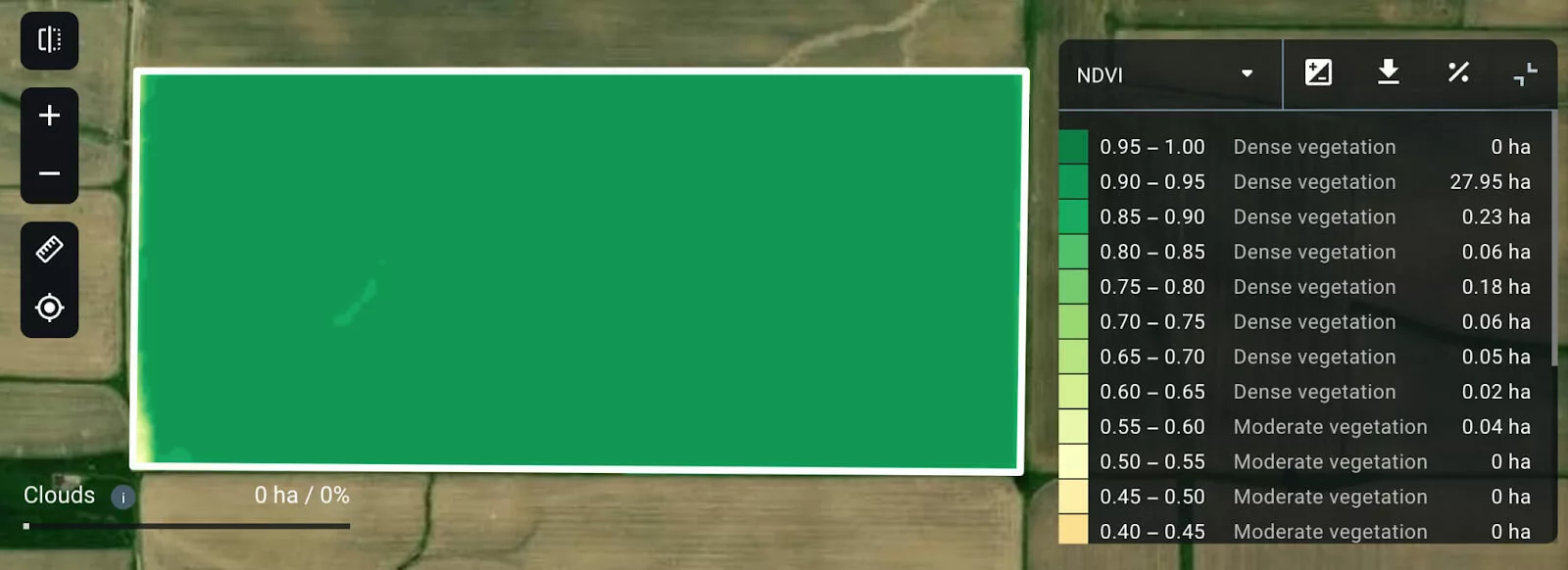
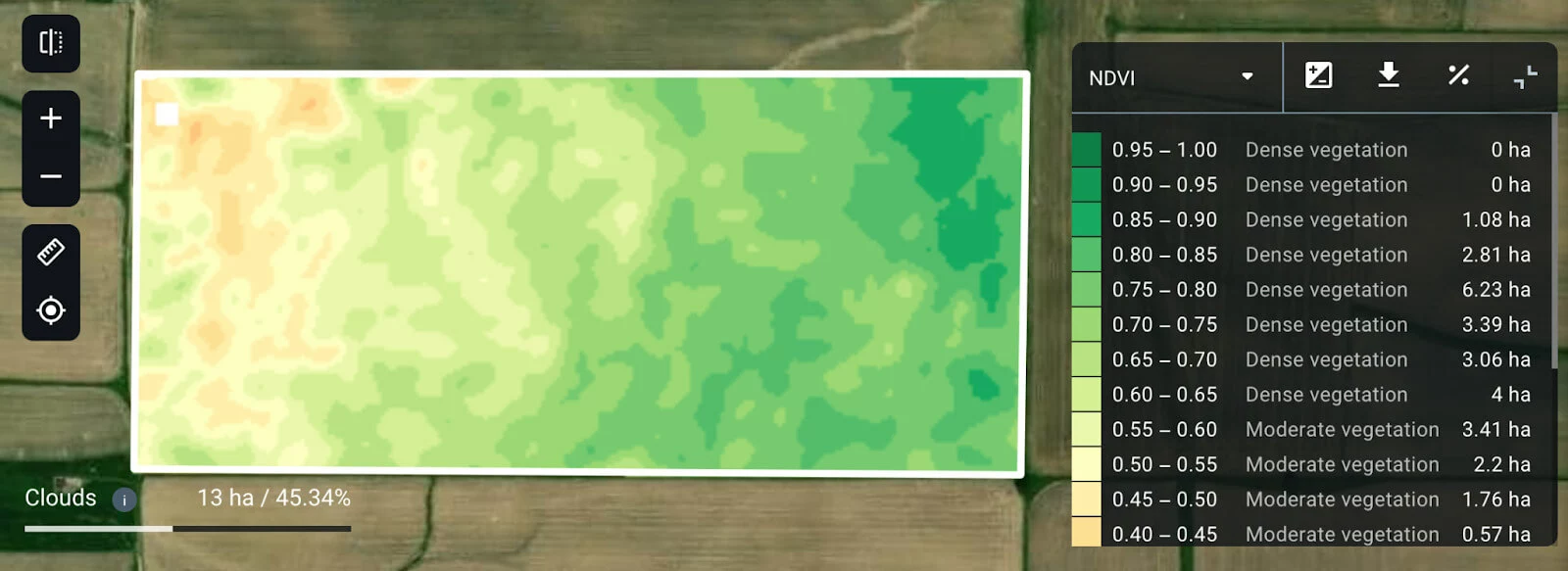
Wilting Of Plants Due To Nutrient Excess Or Deficiency
Vegetation may suffer from nutrient imbalance, alongside other causes of wilting. When plants are deprived of nutrients, they grow slowly. The danger of mineral excess may cause fertilizer burn from nutrient toxicity or abnormal vegetation development. Crops need certain minerals at a certain phenological stage, and nutrient imbalance will make plants use their energy wrong. For example, nitrogen stimulates active foliage growth but when it’s high time for fruit formation, vegetation requires phosphorus. In either case, the development will be impaired, and wilting leaves on plants may signal deviances.
An imbalance of various nutrients reveals differently and also depends on the type of crops. For example, due to nitrogen deficiency, leaves lose their green color, wilt, become thin and weak. The symptoms are primarily explained by a lack of chlorophyll content in wilting crops, which can be tracked with ReCI. Such problems are not apparent, so they are often impossible to identify at once, but can be clearly understood after soil testing. Nonetheless, field monitoring and analysis of trends simplify decision-making in the next seasons.
The slides reveal nitrogen deficiency in wheat from March 15 to April 21, 2020.
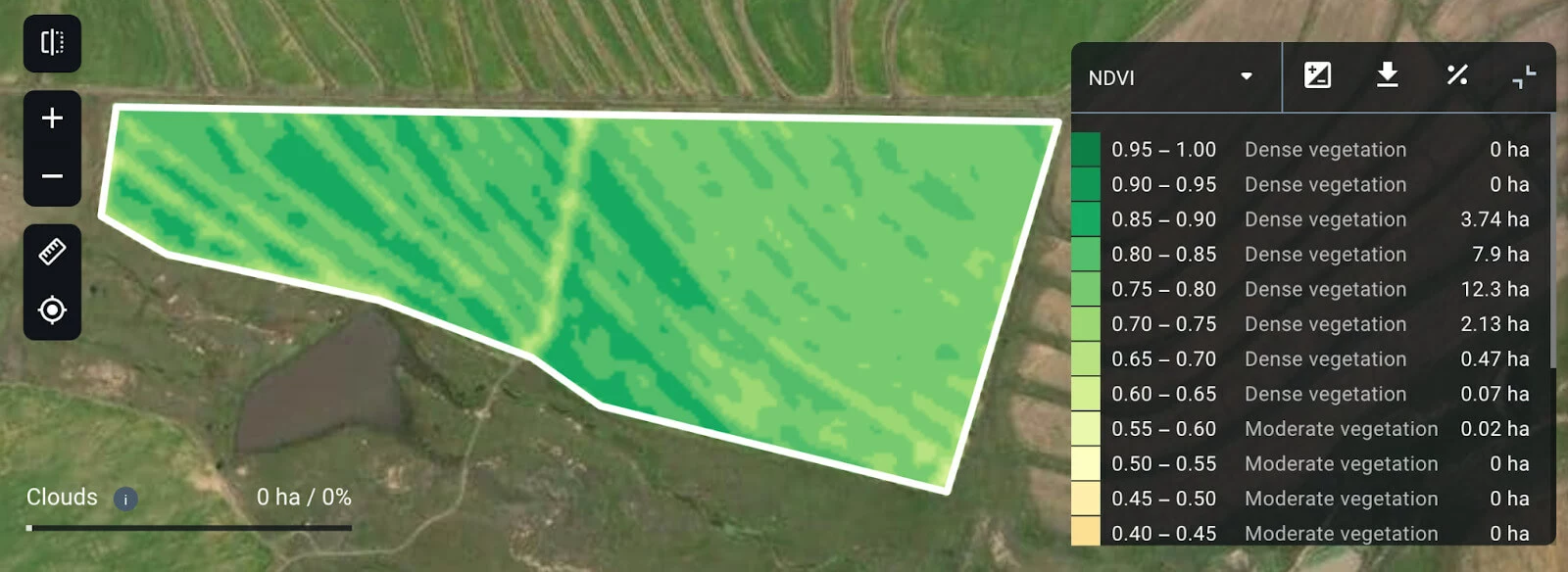
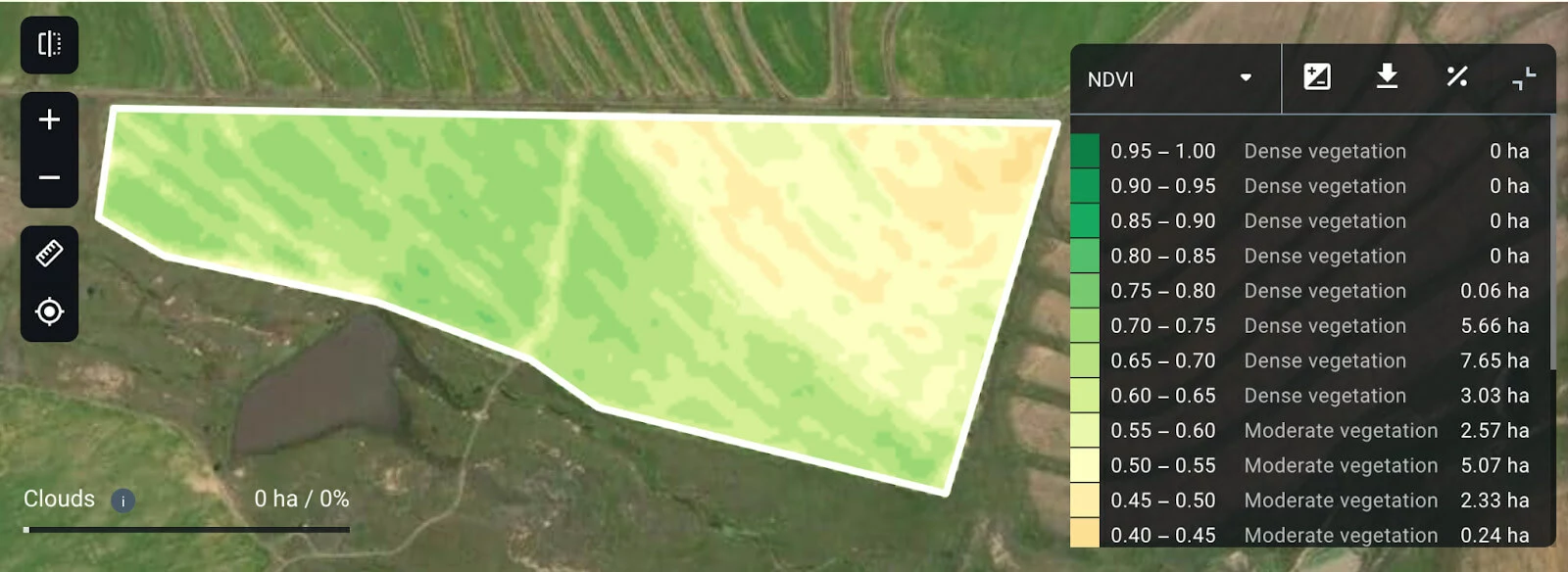
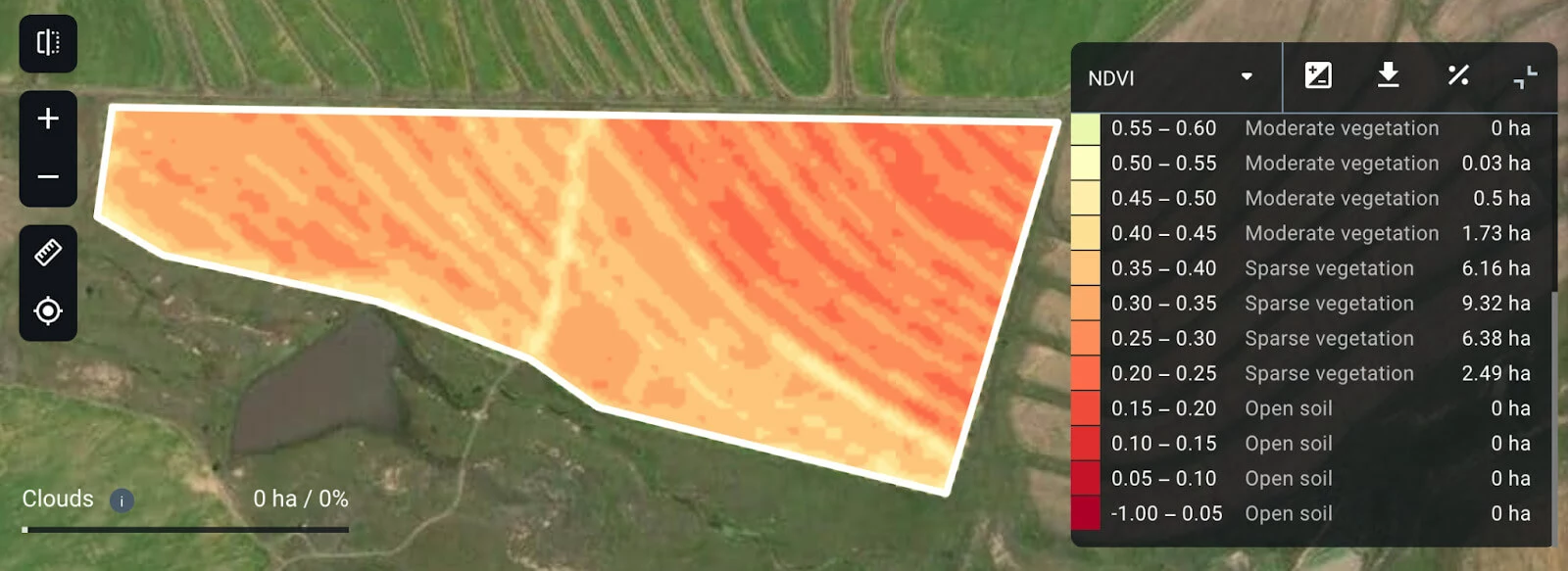
EOSDA Crop Monitoring To Detect And Help Wilting Plants Timely
Vegetation analytics on EOSDA Crop Monitoring detect the problem in time and summon for proper actions. Abnormal values of vegetation indices mean crop development deviances for many reasons that may be revealed by leaves wilting on plants. Besides, vegetation indices on the platform correlate with weather analytics and data on soil moisture, providing comprehensive insights on the field state and growth conditions.
Weather forecasts inform users of probable vegetation stresses due to heat or cold, droughts or waterlogging. Historical data helps outline trends and understand the causes of damage, which is useful to validate crop insurance claims.
The scouting feature on EOSDA Crop Monitoring also saves time for human scouting resources with marked critical areas for inspection instead of checking the whole field. Based on scouting reports, farmers can identify and control the cause and avoid severe yield losses thanks to detecting early signs of plants wilting.
Thus, EOSDA Crop Monitoring is a reliable tool for knowledgeable decision-making. The platform helps timely identify the problem, track correspondences, and develop a plan to save yields.